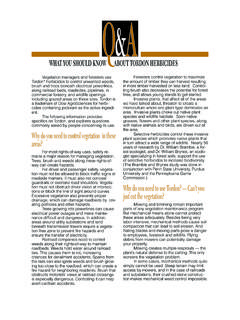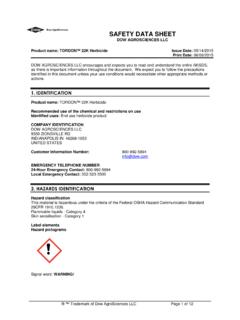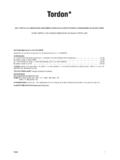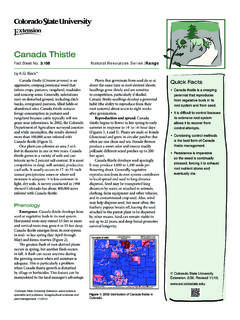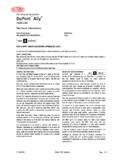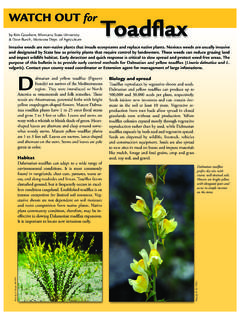Transcription of Plains Prickly Pear Cactus Control - …
1 Plains Prickly Pear Cactus ControlCooperative Extension ServiceWilliam R. Taylor, University Extension EducatorTom D. Whitson, Extension Weed SpecialistPlains Prickly Pear CactusPrickly pear is a native plant commonly found on dry,sandy soils, and it can be troublesome on overgrazedpastures and rangelands. This plant has no forage valuefor livestock unless the spines are burned from the padsso animals can eat them. Many wildlife species, such aspronghorn, deer, rodents, and box turtles, eat the rootsand pads. Although the plant is not poisonous, thespines may cause , the plant has been used to make humanfood; people made jellies from the fruit, and the spineswere sometimes burned off so the pad could be peeledand eaten. Native Americans also used the spines tolance boils, and the mucilaginous juice from the padswas applied over paint on hides to make the paint Prickly pear Cactus (Opuntia polyacantha Haw.)
2 Isa perennial plant that forms low, spreading clumps,measuring 3 feet or more in height. This Cactus repro-duces from stems or seeds. The flat, jointed stems have4/5- to 1 1/5-inch spines, and each plant contains ap-proximately nine stems. Plains Prickly pear Cactus pro-duces large flowers with several united petals, measuringbetween 1 and 2 inches long, and their stamens arecontained in several rows. Flowers vary in color fromlemon yellow to orange, and it is rare to find plainsprickly pear Cactus with red, copper, or pink pear-shaped fruit can be either juicy or dry, and itis often spiny. The numerous white flat seeds measurebetween 2/10 to 3/10 inches long. Roots are fibrousand thick and often develop from disturbed pads. Manyspecies of Opuntia are found in the Caused by CactusPlains Prickly pear Cactus is pervasive throughout thewestern states and can especially become a problem inpastures that have been overgrazed or where other dis-turbances have made conditions favorable for invasionand/or the spread of Cactus .
3 By preventing land frombeing grazed and making it difficult for livestock,horses, other animals, and humans to travel, widespreadand severe infestations can render pastures and rangeareas virtually livestock will not graze grasses growing around,or through, Cactus for fear of getting spines in theirmuzzles or tongues, a 6- to 8-inch buffer strip of grassaround each Cactus plant is created. The ungrazed por-tion of land may actually comprise twice the area of thatcovered by the Cactus a pasture producing 1,000 pounds of forage per acreper year develops a 20 percent Cactus infestation, 30 to40 percent of the forage becomes useless. Losing 35 per-cent of the forage means that a producer can lose 350pounds of dry matter per acre per year. This corre-sponds to approximately one-half of an animal unitmonth (AUM) of forage for a 1,000 pound cow.
4 Be-cause rangeland currently leases for approximately $15per AUM, that equals a loss of $ per acre per 20 percent Cactus infestation on 1,000 acres on thatsame range equals a $7,500 of AgricultureJune 1999B-1074 Controlling Plains Prickly Pear CactusResearch shows that Plains Prickly pear Cactus can becontrolled using a reduced herbicide rate. The recom-mended herbicide for Prickly pear Control is picloram(Tordon 22K), which is manufactured by DowAgroSciences. The label for Tordon 22K advises users toapply 16 ounces (1 pint) of active ingredient per acrewhen applications are made during non-bloom growthstages. However, when applications are made at thebloom stage, 8 ounces (1/2 pint) of Tordon 22K may beused to reduce Plains Prickly pear stands full bloom stage is a critical time for Plains pricklypear susceptibility to picloram. If picloram is appliedduring this growth stage, effective Control can be at-tained with an application of 8 fluid ounces per acre;whereas, applications made at other times or growthstages require a rate of 16 fluid ounces per acre.
5 Plainsprickly pear plants susceptibility to picloram decreasesdramatically both before and after full bloom. Experi-mental plots with even as much as one-third of theplants in bloom, in which herbicide is applied at a rateof 16 fluid ounces, are not controlled as completely asplots at full bloom that receive the herbicide at the re-duced the herbicide is applied at the lower rate, it takeslonger to achieve the same degree of Control . Because cac-tus has a slow metabolism and grows in dry areas, the fulleffect of a single treatment is not seen for four to fiveyears. Picloram remains active in the soil and plant forseveral years, and the Cactus plant continues to weakenuntil death occurs or the effect diminishes to the pointwhere the plant is able to regain its experimental plots of Plains Prickly pear aresprayed at full bloom with 16 fluid ounces of picloramin a single application, 91 percent Control is accom-plished in three years, and 100 percent Control isachieved in five years.
6 Reducing the application rate to8 ounces and spraying a single application at full bloomproduces 75 percent Control in three years and 100 per-cent Control in five on the results of experiments conducted inWeston and Niobrara Counties, it is recommended thatpicloram be applied to Plains Prickly pear Cactus inWyoming during the full bloom stage at a rate of 8ounces per acre. If it is not possible to apply picloram atfull bloom, it is suggested that the 16 ounce per acrerate be reduced rate of 8 ounces per acre of Tordon 22 Kshould only be used if Plains Prickly pear Cactus is thesole weed species being controlled. In many cases otherimportant rangeland weeds, such as fringed sagebrushor broom snakeweed, are present. When controllingthese weeds as well as Plains Prickly pear, a rate of 16ounces of Tordon 22K per acre should be of ControlThe cost of Tordon 22K in 1999 is approximately $80per gallon.
7 This translates into a cost of $5 per acre foran application of 8 ounces. Aerial application rates varyfrom $ to $5 per acre. So, total treatment cost isapproximately $10 per acre for 8-ounce discussed above, a 20 percent Cactus infestation cancreate a $ per acre loss in forage dry matter on atypical pasture. Consequently, the cost of applicationwould be paid for in additional forage within the firstyear or two, even if full Control is not achieved until thethird Stubbendieck, Geir Y. Friisoe, and Margaret R. Block, Weeds of Nebraska and the Great Plains (NebraskaDepartment of Agriculture, 1994), Whitson, ed., Weeds of the West (Western Society of Weed Science, January, 1991), or brand names used in this publication are used only for the purpose of educational information. The information given herein is supplied with the understanding that no discrimination isintended, and no endorsement information of products by the Agricultural Research Service, Federal Extension Service, or State Cooperative Extension Service is implied.
8 Nor does it imply approvalof products to the exclusion of others which may also be in furtherance of Cooperative Extension work, Acts of May 8 and June 30, 1914, in cooperation with the Department of Agriculture, Glen Whipple, Director, Cooperative ExtensionService, University of Wyoming, Laramie, WY seeking admission, employment, or access to programs of the University of Wyoming shall be considered without regard to race, color, national origin, sex, age, religion, political belief, disability, veteranstatus, and marital or familial status. Persons with disabilities who require alternative means for communication or program information (Braille, large print, audiotape, etc.) should contact their local UWExtension Office. To file a complaint, write the UW Employment Practices/Affirmative Action Office, University of Wyoming, Box 3434, Laramie, Wyoming : Diana Marie Hill-Chavez

